Chao Gao
Jun
Beyond Demographics: Enhancing Cultural Value Survey Simulation with Multi-Stage Personality-Driven Cognitive Reasoning
Aug 25, 2025



Abstract:Introducing MARK, the Multi-stAge Reasoning frameworK for cultural value survey response simulation, designed to enhance the accuracy, steerability, and interpretability of large language models in this task. The system is inspired by the type dynamics theory in the MBTI psychological framework for personality research. It effectively predicts and utilizes human demographic information for simulation: life-situational stress analysis, group-level personality prediction, and self-weighted cognitive imitation. Experiments on the World Values Survey show that MARK outperforms existing baselines by 10% accuracy and reduces the divergence between model predictions and human preferences. This highlights the potential of our framework to improve zero-shot personalization and help social scientists interpret model predictions.
GLASS: Test-Time Acceleration for LLMs via Global-Local Neural Importance Aggregation
Aug 19, 2025Abstract:Deploying Large Language Models (LLMs) on edge hardware demands aggressive, prompt-aware dynamic pruning to reduce computation without degrading quality. Static or predictor-based schemes either lock in a single sparsity pattern or incur extra runtime overhead, and recent zero-shot methods that rely on statistics from a single prompt fail on short prompt and/or long generation scenarios. We introduce A/I-GLASS: Activation- and Impact-based Global-Local neural importance Aggregation for feed-forward network SparSification, two training-free methods that dynamically select FFN units using a rank-aggregation of prompt local and model-intrinsic global neuron statistics. Empirical results across multiple LLMs and benchmarks demonstrate that GLASS significantly outperforms prior training-free methods, particularly in challenging long-form generation scenarios, without relying on auxiliary predictors or adding any inference overhead.
TopoDiffuser: A Diffusion-Based Multimodal Trajectory Prediction Model with Topometric Maps
Aug 01, 2025Abstract:This paper introduces TopoDiffuser, a diffusion-based framework for multimodal trajectory prediction that incorporates topometric maps to generate accurate, diverse, and road-compliant future motion forecasts. By embedding structural cues from topometric maps into the denoising process of a conditional diffusion model, the proposed approach enables trajectory generation that naturally adheres to road geometry without relying on explicit constraints. A multimodal conditioning encoder fuses LiDAR observations, historical motion, and route information into a unified bird's-eye-view (BEV) representation. Extensive experiments on the KITTI benchmark demonstrate that TopoDiffuser outperforms state-of-the-art methods, while maintaining strong geometric consistency. Ablation studies further validate the contribution of each input modality, as well as the impact of denoising steps and the number of trajectory samples. To support future research, we publicly release our code at https://github.com/EI-Nav/TopoDiffuser.
Re-ttention: Ultra Sparse Visual Generation via Attention Statistical Reshape
May 28, 2025Abstract:Diffusion Transformers (DiT) have become the de-facto model for generating high-quality visual content like videos and images. A huge bottleneck is the attention mechanism where complexity scales quadratically with resolution and video length. One logical way to lessen this burden is sparse attention, where only a subset of tokens or patches are included in the calculation. However, existing techniques fail to preserve visual quality at extremely high sparsity levels and might even incur non-negligible compute overheads. % To address this concern, we propose Re-ttention, which implements very high sparse attention for visual generation models by leveraging the temporal redundancy of Diffusion Models to overcome the probabilistic normalization shift within the attention mechanism. Specifically, Re-ttention reshapes attention scores based on the prior softmax distribution history in order to preserve the visual quality of the full quadratic attention at very high sparsity levels. % Experimental results on T2V/T2I models such as CogVideoX and the PixArt DiTs demonstrate that Re-ttention requires as few as 3.1\% of the tokens during inference, outperforming contemporary methods like FastDiTAttn, Sparse VideoGen and MInference. Further, we measure latency to show that our method can attain over 45\% end-to-end % and over 92\% self-attention latency reduction on an H100 GPU at negligible overhead cost. Code available online here: \href{https://github.com/cccrrrccc/Re-ttention}{https://github.com/cccrrrccc/Re-ttention}
HyperDet: Source Detection in Hypergraphs via Interactive Relationship Construction and Feature-rich Attention Fusion
May 19, 2025Abstract:Hypergraphs offer superior modeling capabilities for social networks, particularly in capturing group phenomena that extend beyond pairwise interactions in rumor propagation. Existing approaches in rumor source detection predominantly focus on dyadic interactions, which inadequately address the complexity of more intricate relational structures. In this study, we present a novel approach for Source Detection in Hypergraphs (HyperDet) via Interactive Relationship Construction and Feature-rich Attention Fusion. Specifically, our methodology employs an Interactive Relationship Construction module to accurately model both the static topology and dynamic interactions among users, followed by the Feature-rich Attention Fusion module, which autonomously learns node features and discriminates between nodes using a self-attention mechanism, thereby effectively learning node representations under the framework of accurately modeled higher-order relationships. Extensive experimental validation confirms the efficacy of our HyperDet approach, showcasing its superiority relative to current state-of-the-art methods.
SourceDetMamba: A Graph-aware State Space Model for Source Detection in Sequential Hypergraphs
May 19, 2025Abstract:Source detection on graphs has demonstrated high efficacy in identifying rumor origins. Despite advances in machine learning-based methods, many fail to capture intrinsic dynamics of rumor propagation. In this work, we present SourceDetMamba: A Graph-aware State Space Model for Source Detection in Sequential Hypergraphs, which harnesses the recent success of the state space model Mamba, known for its superior global modeling capabilities and computational efficiency, to address this challenge. Specifically, we first employ hypergraphs to model high-order interactions within social networks. Subsequently, temporal network snapshots generated during the propagation process are sequentially fed in reverse order into Mamba to infer underlying propagation dynamics. Finally, to empower the sequential model to effectively capture propagation patterns while integrating structural information, we propose a novel graph-aware state update mechanism, wherein the state of each node is propagated and refined by both temporal dependencies and topological context. Extensive evaluations on eight datasets demonstrate that SourceDetMamba consistently outperforms state-of-the-art approaches.
Computing High-dimensional Confidence Sets for Arbitrary Distributions
Apr 03, 2025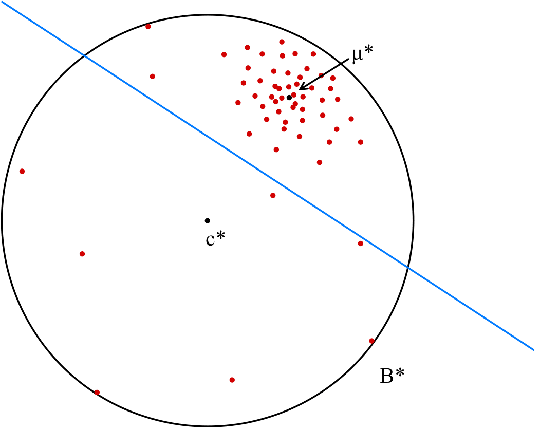
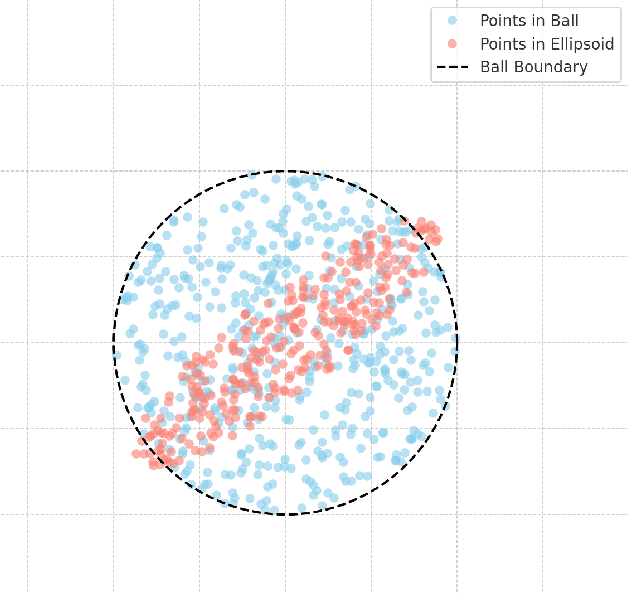
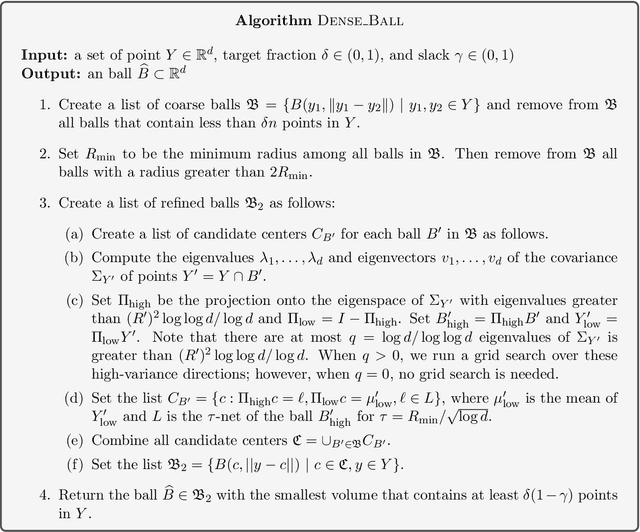
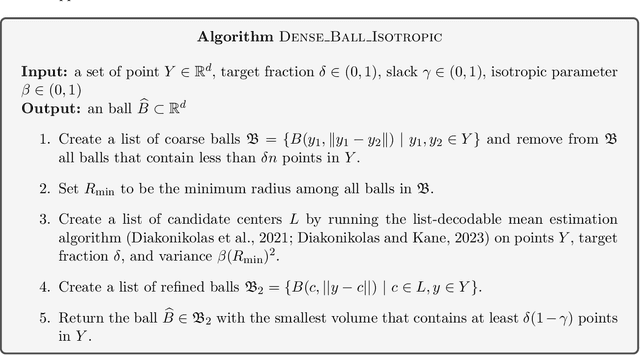
Abstract:We study the problem of learning a high-density region of an arbitrary distribution over $\mathbb{R}^d$. Given a target coverage parameter $\delta$, and sample access to an arbitrary distribution $D$, we want to output a confidence set $S \subset \mathbb{R}^d$ such that $S$ achieves $\delta$ coverage of $D$, i.e., $\mathbb{P}_{y \sim D} \left[ y \in S \right] \ge \delta$, and the volume of $S$ is as small as possible. This is a central problem in high-dimensional statistics with applications in finding confidence sets, uncertainty quantification, and support estimation. In the most general setting, this problem is statistically intractable, so we restrict our attention to competing with sets from a concept class $C$ with bounded VC-dimension. An algorithm is competitive with class $C$ if, given samples from an arbitrary distribution $D$, it outputs in polynomial time a set that achieves $\delta$ coverage of $D$, and whose volume is competitive with the smallest set in $C$ with the required coverage $\delta$. This problem is computationally challenging even in the basic setting when $C$ is the set of all Euclidean balls. Existing algorithms based on coresets find in polynomial time a ball whose volume is $\exp(\tilde{O}( d/ \log d))$-factor competitive with the volume of the best ball. Our main result is an algorithm that finds a confidence set whose volume is $\exp(\tilde{O}(d^{2/3}))$ factor competitive with the optimal ball having the desired coverage. The algorithm is improper (it outputs an ellipsoid). Combined with our computational intractability result for proper learning balls within an $\exp(\tilde{O}(d^{1-o(1)}))$ approximation factor in volume, our results provide an interesting separation between proper and (improper) learning of confidence sets.
Volume Optimality in Conformal Prediction with Structured Prediction Sets
Feb 23, 2025Abstract:Conformal Prediction is a widely studied technique to construct prediction sets of future observations. Most conformal prediction methods focus on achieving the necessary coverage guarantees, but do not provide formal guarantees on the size (volume) of the prediction sets. We first prove an impossibility of volume optimality where any distribution-free method can only find a trivial solution. We then introduce a new notion of volume optimality by restricting the prediction sets to belong to a set family (of finite VC-dimension), specifically a union of $k$-intervals. Our main contribution is an efficient distribution-free algorithm based on dynamic programming (DP) to find a union of $k$-intervals that is guaranteed for any distribution to have near-optimal volume among all unions of $k$-intervals satisfying the desired coverage property. By adopting the framework of distributional conformal prediction (Chernozhukov et al., 2021), the new DP based conformity score can also be applied to achieve approximate conditional coverage and conditional restricted volume optimality, as long as a reasonable estimator of the conditional CDF is available. While the theoretical results already establish volume-optimality guarantees, they are complemented by experiments that demonstrate that our method can significantly outperform existing methods in many settings.
HawkBench: Investigating Resilience of RAG Methods on Stratified Information-Seeking Tasks
Feb 19, 2025Abstract:In real-world information-seeking scenarios, users have dynamic and diverse needs, requiring RAG systems to demonstrate adaptable resilience. To comprehensively evaluate the resilience of current RAG methods, we introduce HawkBench, a human-labeled, multi-domain benchmark designed to rigorously assess RAG performance across categorized task types. By stratifying tasks based on information-seeking behaviors, HawkBench provides a systematic evaluation of how well RAG systems adapt to diverse user needs. Unlike existing benchmarks, which focus primarily on specific task types (mostly factoid queries) and rely on varying knowledge bases, HawkBench offers: (1) systematic task stratification to cover a broad range of query types, including both factoid and rationale queries, (2) integration of multi-domain corpora across all task types to mitigate corpus bias, and (3) rigorous annotation for high-quality evaluation. HawkBench includes 1,600 high-quality test samples, evenly distributed across domains and task types. Using this benchmark, we evaluate representative RAG methods, analyzing their performance in terms of answer quality and response latency. Our findings highlight the need for dynamic task strategies that integrate decision-making, query interpretation, and global knowledge understanding to improve RAG generalizability. We believe HawkBench serves as a pivotal benchmark for advancing the resilience of RAG methods and their ability to achieve general-purpose information seeking.
OpenBench: A New Benchmark and Baseline for Semantic Navigation in Smart Logistics
Feb 13, 2025
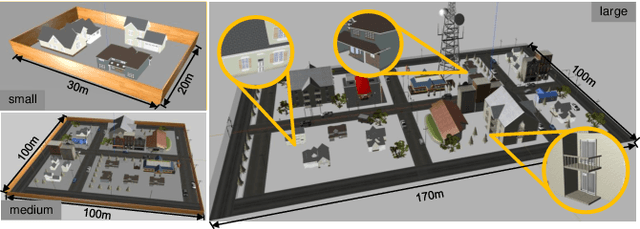

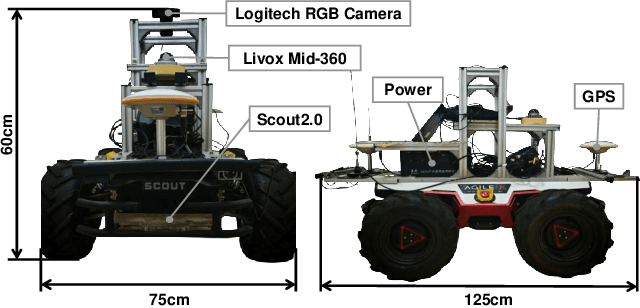
Abstract:The increasing demand for efficient last-mile delivery in smart logistics underscores the role of autonomous robots in enhancing operational efficiency and reducing costs. Traditional navigation methods, which depend on high-precision maps, are resource-intensive, while learning-based approaches often struggle with generalization in real-world scenarios. To address these challenges, this work proposes the Openstreetmap-enhanced oPen-air sEmantic Navigation (OPEN) system that combines foundation models with classic algorithms for scalable outdoor navigation. The system uses off-the-shelf OpenStreetMap (OSM) for flexible map representation, thereby eliminating the need for extensive pre-mapping efforts. It also employs Large Language Models (LLMs) to comprehend delivery instructions and Vision-Language Models (VLMs) for global localization, map updates, and house number recognition. To compensate the limitations of existing benchmarks that are inadequate for assessing last-mile delivery, this work introduces a new benchmark specifically designed for outdoor navigation in residential areas, reflecting the real-world challenges faced by autonomous delivery systems. Extensive experiments in simulated and real-world environments demonstrate the proposed system's efficacy in enhancing navigation efficiency and reliability. To facilitate further research, our code and benchmark are publicly available.
 Add to Chrome
Add to Chrome Add to Firefox
Add to Firefox Add to Edge
Add to Edge